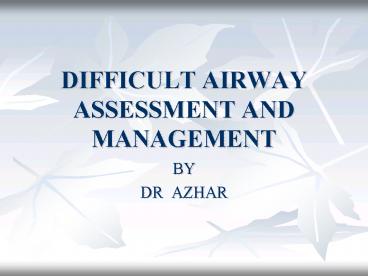DIFFICULT AIRWAY ASSESSMENT AND MANAGEMENT - PowerPoint PPT Presentation
1 / 23
Title:
DIFFICULT AIRWAY ASSESSMENT AND MANAGEMENT
Description:
... Robershaw , Mackintosh and relatively new laryngoscope McCoy. ... Bullard laryngoscope Fiber optic. Mini Tracheostomy. Mini Tracheostomy (Cont.) BLIND NASAL, ... – PowerPoint PPT presentation
Number of Views:3371
Avg rating:4.5/5.0
Title: DIFFICULT AIRWAY ASSESSMENT AND MANAGEMENT
1
DIFFICULT AIRWAYASSESSMENT ANDMANAGEMENT
- BY
- DR AZHAR
2
DEFFINATION
- American society of Anesthesiologist (ASA)
suggested that when sign of inadequate
ventilation could not be reversed by mask
ventilation or oxygen saturation could not be
maintained above 90 or - if a trained Anaesthetist usinig conventional
larangoscope takes more than 3 attempts or - more than 10 minute are required to complete
tracheal intubation
3
Anatomy of oropharynex and larynx
4
PREVALENCE
- Fact of the matter is even with proper evaluation
only 15 to 50 were picked up while difficult
face mask ventilation in general is about
110,000 out of which again 15 proved to be the
difficult intubation ,while incidence of extreme
difficult or abandons intubation in general
surgery patients are 12000 but in obstetrics is
1300 and of course most critical incidence is
Hypoxia
5
BASIC AIRWAY EVALUATION
- Previous anaesthetic problems and general
appearance of the patient. - Neck, face, maxilla and mandible with jaw
movements. - Head extension and movements, teeth, oropharanx
and soft tissue of the neck .
6
Why does it happens ?
- Exaggerated idea of personal ability.
- Not requesting for experienced help.
- No discussion with colleagues about proposed
management of the case . - Ill conceived plan (A) with no proper back up
plan (B). - Even poorly conducted plan (A) or sticking extra
time to the plan (A) other way delaying the
rescue plan late. - Last not the least not involving surgical
friends.
7
CAUSES OF DIFFICULT INTUBATION
- Anaesthetist
- Inadequate preoperative assessment.
- Inadequate equipments.
- Experience not enough.
- Poor technique.
- Malfunctioning of equipment.
- Inexperience assistanance
- Patient
- Congenital causes
- Acquired causes
8
Anatomical factors affecting Larangoscopy
- Short Neck.
- Protruding incisor teeth.
- Long high arched palate.
- Poor mobility of neck.
- Increase in either anterior depth or Posterior
depth of the mandible decrease in Atlanto
Occipital distance that's why role of Radiology
has increased in our specialty
9
ASSESSMENT OF AIRWAY
- Mallampati classification with larangoscopic
view.
Patils Test
10
Measurement of Atlanto-Occepital Angle
11
MANAGEMENT PLAN OF ANTICEPATED DIFFICULT AIRWAY
- Discussion with colleagues in advance.
- Equipment tested before.
- Senior help backup.
- Definite initial plan (A) for ventilation and
intubation. - Definite plan (B) than option of awake
intubation. - Ideal situation surgery team standby.
12
UNEXPECTED DIFFICULT AIRWAY Problems
- Unexpected encounter with difficult airway is
mostly gone worse because mainly GA is already
given including (NMB,S). - Equipment may not be in hand.
- Senior and back up plan not available so delay
occur in active resuscitation - TECHNIQUE OF MANAGEMENT
- Manipulation of the patients airway.
- Laryngeal pressure.
- Nasal or oral airway.
- Different blades of larangoscope like Miller,
Magill, Robershaw , Mackintosh and relatively new
laryngoscope McCoy. - Bougies and stylet
- LMA.
- Combitube.
13
1 Manipulation of airway different blade,
bugie 2 LMA, ILMA, Combitube 3 Trantracheal
Jet Ventilation 4 Cricothireotomy,
Tracheostomy
14
GALLERY OF TOOLS
15
GALLERY OF TOOLS
- Bullard laryngoscope Fiber optic
16
Mini Tracheostomy
17
Mini Tracheostomy (Cont.)
18
BLIND NASAL,RETROGRADE AND HIGH FREQUENCY
VENTILATION
19
Awake Intubation
20
ASA ALLOGORYTHAM
21
ASA ALLGORYTHAM
22
C-SPINE OA
23
THANK YOU VERY MUCH FOR YOUR ATTENTION































